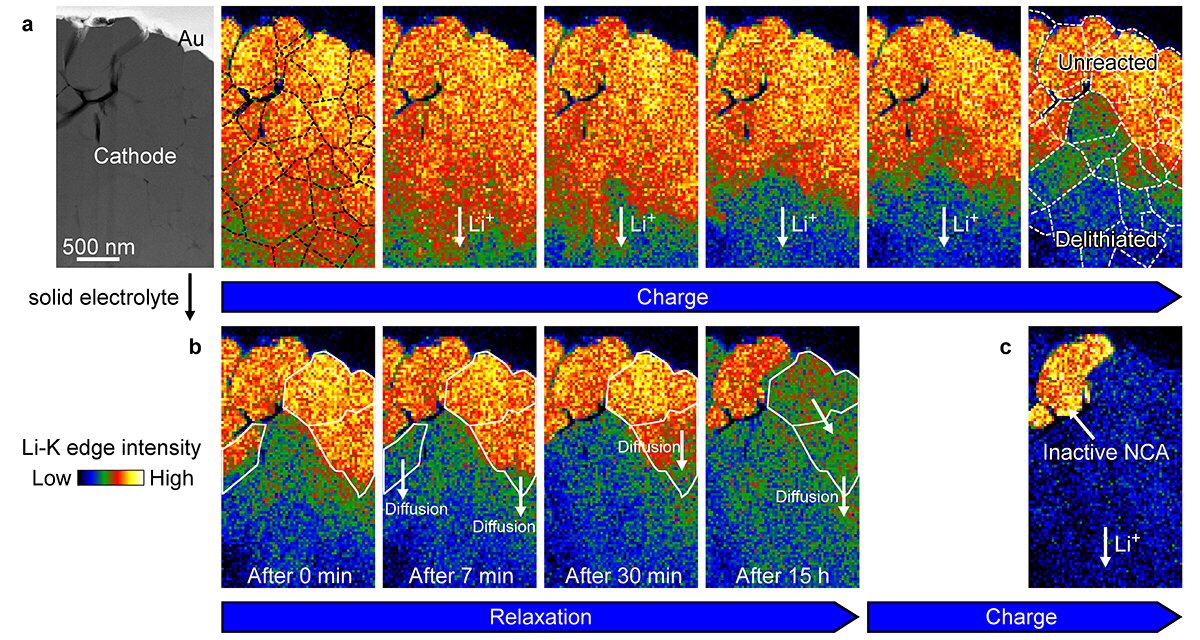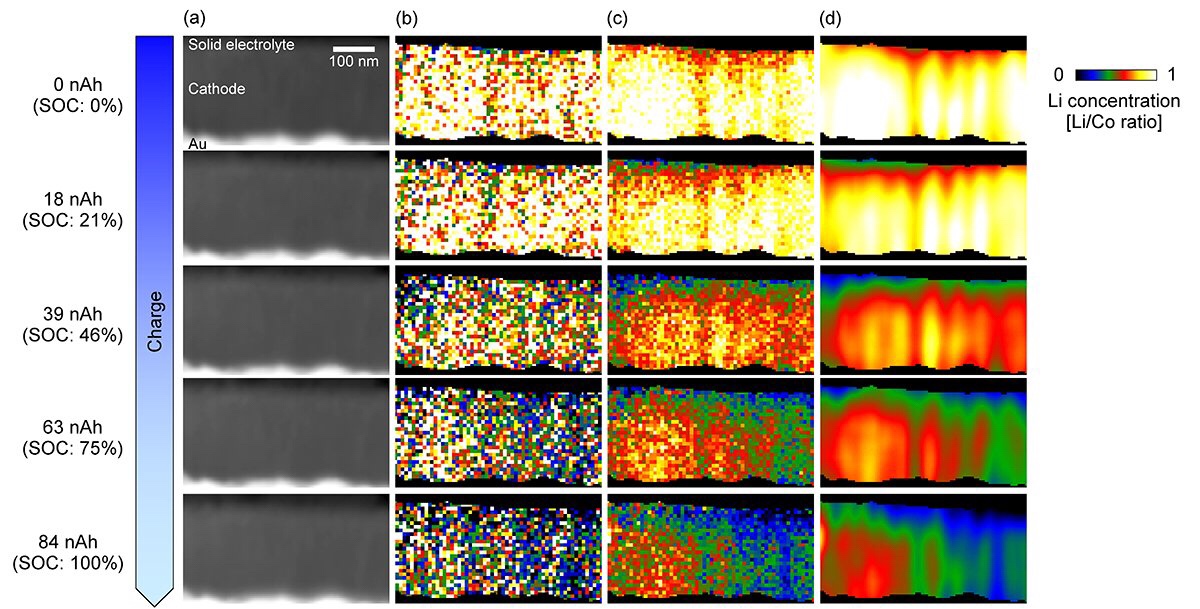
Fig. 1: Real-time observation of lithium ions in cathode materials of the bulk-type all-solid-state batteries.
(a) STEM image and corresponding lithium maps showing the lithium dynamics during high-speed charging. The black and white broken lines indicate the crystal grain boundaries of primary cathode particles.
(b) Relaxed distribution of lithium following the high-speed charging.
(c) Lithium distribution following low-speed charging. (Figures have been partially modified and reproduced with permission from the below-mentioned article *a. Copyright 2020 American Chemical Society.)

Fig. 2: Real-time observation of lithium ions in thin-film-type all-solid-state batteries.
(a) (in column) STEM images.
(b) Noisy, low-resolution images showing lithium distribution, recorded at a high scanning speed condition.
(c) Images calculated from (b) using spectral fitting, showing lithium distribution with noise reduction.
(d) Images from (c) using sparse coding, showing super-resolved lithium distribution without noise.
(Figures have been partially modified and reproduced from the below-mentioned article *b. Copyright 2020 Springer Nature.)
Panasonic: Visualization of lithium ion movement: Charge/discharge of all solid state batteries
-Enables thin film type and bulk type analysis-
Panasonic:
Fine Ceramics Center (JFCC), Future Materials and Systems Laboratory, Nagoya University
Together, we have developed a technology for observing the movement of lithium ions during charge/discharge of an all-solid-state battery in real time with nanometer resolution.
Observe in real time with a transmission electron microscope and machine learning.
All-solid-state lithium-ion battery:
It can realize high safety and energy density, and is expected as a next-generation secondary battery.
In the future, it is necessary to accurately understand the movement of lithium ions inside the battery in order to develop higher performance batteries.
Operand Transmission Electron Microscope Analysis Technology:
So far, Panasonic, JFCC and Nagoya University have jointly developed “operand transmission electron microscope analysis technology” that can visualize the movement of lithium ions inside thin-film all-solid-state batteries.
Application to bulk type all solid state battery:
This time, we applied this technology to bulk-type all-solid-state batteries.
At the same time, the image shooting time has been greatly reduced.
Previously, it took 15 minutes per image, but this was reduced to 30 seconds.
As a result, regarding thin-film type and bulk type all-solid-state batteries,
The movement of lithium ions flowing inside
With a spatial resolution of nanometers,
It became possible to observe in real time.
Developed technology:
From this, it was clarified that the lithium ions were charged and discharged in a complicated diffusion process.
If this research result is utilized,
It is possible to design batteries with low internal resistance,
It is said that high-performance all-solid-state batteries can be realized.
EE Times Japan
https://eetimes.jp/ee/spv/2007/14/news035.html
Panasonic Announces Development of Real Time Observation Technique to Reveal Lithium-Ion Dynamics During Charge and Discharge in All-Solid-State Batteries |
Osaka, Japan – On July 9, 2020,
Panasonic Corporation
announced development of technique to visualize lithium-ion dynamics in all-solid-state batteries on a nanometer scale in real time, in collaboration with
Japan Fine Ceramics Center (JFCC) and Institute of Materials and Systems for Sustainability,
Nagoya University.
The technique, which makes use of scanning transmission electron microscopy (STEM) and machine learning, was applied to both bulk-type and thin-film-type all-solid-state lithium ion batteries.
This technique
has enabled the visualization of lithium ion transfer resistance, which has revealed that the lithium ions are charged and discharged with complex diffusion processes,
and their movements
are disturbed at crystal grain boundaries within cathode materials. These findings clarified the criteria for designing high-performance all-solid-state batteries, and will therefore make huge contributions to their future development.
These research results
were published in the online version of ACS Energy Letters (May 27, 2020) and the online version of Nature Communications (June 4, 2020).
Both studies were partially supported by a Grant-in-Aid for Scientific Research KAKENHI (JP17H02792) from the Japan Society for the Promotion of Science (JSPS).
Panasonic Newsroom Global grain boundaries within cathode materials. These findings clarified the criteria for designing high-performance all-solid-state batteries, and will therefore make huge contributions to their future development.
Panasonic Newsroom Global